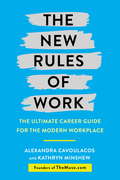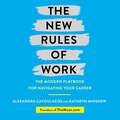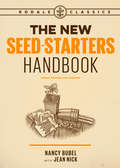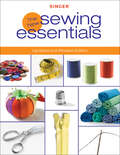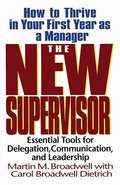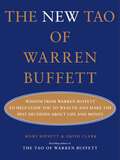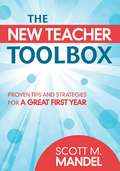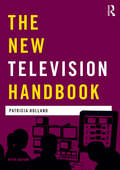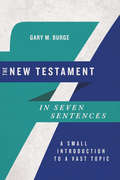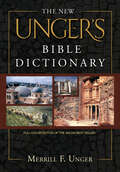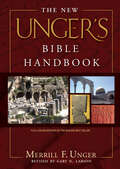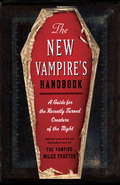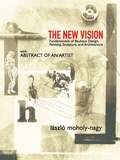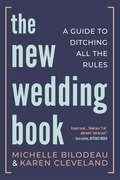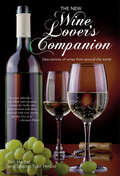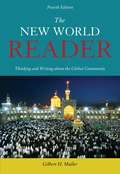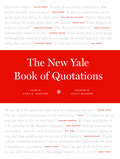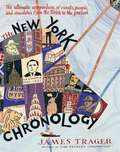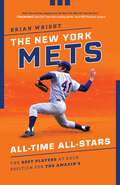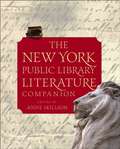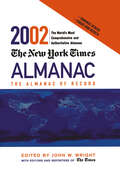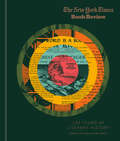- Table View
- List View
The New Rules of Work: The ultimate career guide for the modern workplace
by Alexandra Cavoulacos Kathryn MinshewThe modern playbook to finding the perfect career path, landing the right job, and waking up excited for work every day, from founders of online network TheMuse.com.'In today's digital age, finding job listings and endless data about those jobs is easy. What's difficult is making sense of it all. With The New Rules of Work, Muse founders Alexandra Cavoulacos and Kathryn Minshew give us the tools we need to navigate the modern job search and align our careers with our true values and passions.' Arianna Huffington, Founder and CEO Thrive Global, NYT Bestselling author In this definitive guide to the ever-changing modern workplace, Kathryn Minshew and Alexandra Cavoulacos, the co-founders of popular career website TheMuse.com, show how to find your perfect career. Through quick exercises and structured tips, the authors guide you as you sort through your countless options; communicate who you are and why you are valuable; and stand out from the crowd. The New Rules of Work shows how to choose a perfect career path, land the best job, and wake up feeling excited to go to work every day-- whether you are starting out in your career, looking to move ahead, navigating a mid-career shift, or anywhere in between.
The New Rules of Work: The ultimate career guide for the modern workplace
by Alexandra Cavoulacos Kathryn MinshewIn this definitive guide to the ever-changing modern workplace, Kathryn Minshew and Alexandra Cavoulacos, the co-founders of popular career website TheMuse.com, show how to find your perfect career. Through quick exercises and structured tips, the authors guide you as you sort through your countless options; communicate who you are and why you are valuable; and stand out from the crowd. The New Rules of Work shows how to choose a perfect career path, land the best job, and wake up feeling excited to go to work every day-- whether you are starting out in your career, looking to move ahead, navigating a mid-career shift, or anywhere in between.Written and read by Kathryn Minshew and Alexandra Cavoulacos(p) 2017 Random House Audio
The New Seed-Starters Handbook (Rodale Organic Gardening)
by Nancy Bubel Jean NickStarting plants from a seed grants earlier harvests, greater variety, healthier seedlings, lower costs, and the undeniable sense of satisfaction and reward. For the most complete, up-to-date information on starting plants from seed, turn to The New Seed-Starter's Handbook. Written by a gardener with 30 years of experience, this updated, easy-to-use reference explains everything you need to know to start seeds and raise healthy seedlings successfully. You'll find:- The latest research in seed starting- The best growing media- The newest gardening materials- Solutions to seed-starting problems- Source lists for seeds and hard-to-find gardening suppliesThe robust encyclopedia section lists more than 200 plants—including vegetables and fruits, garden flowers, wildflowers, herbs, trees, and shrubs—with details on how to start each from seed.
The New Sewing Essentials
by Creative Publishing internationalThe popular, step-by-step guide to sewing, revised and updated for today’s sewing enthusiasts.Sewing Essentials, first published in 1984, has long been recognized as the one book every sewing enthusiast should own. This popular book has been updated, making it even more appealing for today’s sewers.Clearly written instructions and more than 450 full-color photographs lead you step-by-step through all common sewing techniques. It’s like having your own personal sewing instructor right beside you. Get professional guidance on all these topics:Sewing equipment and toolsUsing patternsSelecting and preparing fabricsAll kinds of seams and seam finishesDarts, gathers, hems, zippers and buttonholesFacings, cuffs, collars and waistbandsWhether you are just learning to sew or have sewn for years, you’ll find this book a valuable reference. Singer New Sewing Essentials, Updated and Revised Edition is your guide to sewing success.
The New Supervisor: How To Thrive In Your First Year As A Manager
by Martin M. Broadwell Carol Broadwell DietrichMartin Broadwell has dominated the field of management training for over thirty years, inspiring and guiding thousands of front-line managers in virtually every industry, in the U.S. and abroad. In this classic bestseller he offers new managers a comprehensive primer to the essentials of effective management--delegation, problem solving, motivation, time management, communication, and performance appraisal. Now teamed up with his daughter, he has expanded and updated this handy guide to reflect the management issues of the '90s, including stress management and team building. Packed with practical examples, no-nonsense advice, and illustrative exercises, The New Supervisoris an indispensable resource for every manager on the way up.
The New Tao of Warren Buffett: Wisdom from Warren Buffett to Help Guide You to Wealth and Make the Best Decisions About Life and Money (Tao of Warren Buffett #2)
by Mary Buffett David ClarkA new collection of simple yet powerful words and wisdom from Warren Buffett about today&’s economy and how investing has changed in the past two decades—from crypto to climate change—compiled and commented upon by bestselling authors Mary Buffett and David Clark.Warren Buffett&’s investment achievements are unparalleled. He owes his success to hard work, integrity, and the most elusive commodity of all, common sense. In The New Tao of Warren Buffett, Mary Buffett—coauthor of the bestselling Buffettology series—joins David Clark to bring readers more of Warren Buffett&’s smartest, funniest, and most memorable sayings that reveal the life philosophy and the investment strategies that have made Warren Buffett, and the shareholders of Berkshire Hathaway, so enormously wealthy. Culled from a variety of fresh sources, including personal conversations, corporate reports, profiles, and interviews, the new quotations here reflect Warren&’s practical strategies and provide useful tips for every investor, large or small. Including short explanations for each quote and examples from Buffett&’s own business transactions, these ruminations on everything from AI to inflation illustrate his words at work. Inspiring, thought-provoking, and invaluable, this irresistibly browsable book offers priceless investment savvy that anyone can take to the bank—and is destined to become a new classic.
The New Teacher Toolbox: Proven Tips and Strategies for a Great First Year
by Scott M. MandelThis edition is a concise yet complete guide for novice teachers, covering all the essentials for getting off to a good start. With new tips for everything from establishing an ideal classroom environment to making it through teacher evaluations, this revised edition of The New Teacher Toolbox helps you plan ahead with confidence, keep your perspective, and prepare for the unexpected. Scott M. Mandel introduces techniques by grade level, making the book easy to read sequentially or as a reference for specific situations. Written in a conversational tone, this completely revised edition includes an expanded section on Internet use and provides field-tested strategies on how to: · Encourage student participation and critical thinking · Establish fair grading practices · Modify instructional methods and curricula for students with special needs · Increase parent involvement · Manage stress and maintain sanity Even experienced teachers can benefit from the practical and straightforward advice in this guide. A must-have for any educator struggling with parent-teacher conferences, writing report cards, and communicating with TSAs--everything new teachers need to know and are too afraid to ask!
The New Television Handbook (Media Practice)
by Patricia HollandThe New Television Handbook?provides an exploration of the theory and practice of television at a time when the medium is undergoing radical changes. The book looks at television from the perspective of someone new to the industry, and explores the place of the medium within a?constantly changing digital landscape. This title discusses key skills involved in television production, including: producing, production management, directing, camera, sound, editing and visual effects. Each of these activities is placed within a wider context as it traces the production process from commissioning to post-production. The book outlines the broad political and economic context of the television industry. It gives an account of television genres, in particular narrative, factual programmes and news, and it considers the academic discipline of media studies and the ways in which theorists have analysed and tried to understand the medium. It points to the interplay of theory and practice as it draws on the history of the medium and observes the ways in which the past continues to influence and invigorate the present. The New Television Handbook?includes: contributions from practitioners ranging from established producers to new entrants; a comprehensive list of key texts and television programmes; a revised glossary of specialist terms; a section on training and ways of getting into the industry. By combining theory, real-world advice and a detailed overview of the industry and its history,?The New Television Handbook?is an ideal guide for students of media and television studies and young professionals entering the television industry.
The New Testament in Seven Sentences: A Small Introduction to a Vast Topic (Introductions in Seven Sentences)
by Gary M. BurgeWe often explore individual passages of Scripture without seeing the whole. A verse may be inspiring and easy to grasp, but the sweeping context is often difficult and requires persistence. To understand the breadth of the gospel's message, we need to perceive the full tapestry of Scripture with its theological themes woven together. Otherwise, we miss the scope of what Jesus is doing in the New Testament, gaining mere glimpses of his activity or teaching but missing their significance. Gary M. Burge aims to weave this larger tapestry so that each part of the story takes on richer meaning. Using seven key sentences drawn straight from the New Testament, Burge demonstrates how the themes of fulfillment, kingdom, cross, grace, covenant, spirit, and completion set a theological rhythm for our faith. The seven include "You are the Messiah, the son of the living God!" "By grace you have been saved, through faith … not by works." "You are a chosen people, a royal priesthood, a holy nation, God’s special possession." "I saw a new heaven and a new earth." These sentences are not only individually inspiring, but they outline the broader pattern of Scripture that illustrates what God has done—and is bringing to fulfillment—in Christ.
The New Unger's Bible Dictionary
by Merrill F. UngereBook now easier to navigate than everUnger&’s Bible Dictionary has been one of the best-selling Bible dictionaries on the market since its introduction in 1957. Now, this time-honored classic is more valuable than ever. Updated and expanded by respected Bible authorities including R.K. Harrison, Howard F. Vos, and Cyril J. Barber, The New Unger&’s Bible Dictionary is packed with the most current scholarship. Plus, the table of contents is enhanced for easy navigation. Readers can jump to any letter and see a full list of words, allowing them to locate any entry within seconds. No more paging through whole sections of the book to find your word.More than 67,000 entries are supplemented with detailed essays, colorful photography and maps, and dozens of charts and illustrations to enhance your understanding of God&’s Word. Although this volume is based on the New American Standard, extensive cross-referencing makes it useful with all major Bible translations, including the New International, King James, and New King James versions.
The New Unger's Bible Dictionary
by Merrill F. UngereBook now easier to navigate than everUnger&’s Bible Dictionary has been one of the best-selling Bible dictionaries on the market since its introduction in 1957. Now, this time-honored classic is more valuable than ever. Updated and expanded by respected Bible authorities including R.K. Harrison, Howard F. Vos, and Cyril J. Barber, The New Unger&’s Bible Dictionary is packed with the most current scholarship. Plus, the table of contents is enhanced for easy navigation. Readers can jump to any letter and see a full list of words, allowing them to locate any entry within seconds. No more paging through whole sections of the book to find your word.More than 67,000 entries are supplemented with detailed essays, colorful photography and maps, and dozens of charts and illustrations to enhance your understanding of God&’s Word. Although this volume is based on the New American Standard, extensive cross-referencing makes it useful with all major Bible translations, including the New International, King James, and New King James versions.
The New Unger's Bible Handbook
by Merrill F. UngerA rich treasury of Bible information! The New Unger's Bible Handbook remains the one book indispensable to quality study, chock-full of color illustrations, photographs, maps, diagrams, charts and more. Now with updated graphics, this classic is sure to be a favorite among the next generation of Bible scholars.
The New Unger's Bible Handbook
by Merrill F. UngerA rich treasury of Bible information! The New Unger's Bible Handbook remains the one book indispensable to quality study, chock-full of color illustrations, photographs, maps, diagrams, charts and more. Now with updated graphics, this classic is sure to be a favorite among the next generation of Bible scholars.
The New Vampire's Handbook: A Guide for the Recently Turned Creature of the Night
by Joe Garden Chris Pauls Anita Serwacki Scott Sherman Janet GinsburgFrom the authors of "The Dangerous Book for Dogs" and "The Devious Book for Cats" comes this hilarious illustrated guide to the issues facing the newly turned vampire. 100 bw illustrations.
The New Vision: Fundamentals of Bauhaus Design, Painting, Sculpture, and Architecture
by Daphne M. Hoffmann László Moholy-NagyOne of the most important schools for architecture, design, and art in the 20th century, the Weimar Bauhaus included in its distinguished membership Moholy-Nagy. This book, a valuable introduction to the Bauhaus movement, is generously illustrated with examples of students' experiments and typical contemporary achievements. The text also contains an autobiographical sketch.
The New Wedding Book: A Guide to Ditching All the Rules
by Karen Cleveland Michelle BilodeauPlan your wedding without the weight of outdated customs and get hitched in a way that is authentic, fun, and true to who you are.From the minute couples become engaged, they are pressured to buy into a one-size-fits-all wedding. By breaking down the antiquated traditions of that #blessedweddingday,The New Wedding Book will help you and your betrothed throw those icky traditions to the curb in honour of having the wedding of your actual dreams — not the one you’ve been force-fed for decades by the wedding-industrial complex. Inspiring couples to plan their wedding in a way that is meaningful to them, Bilodeau and Cleveland debunk the manufactured traditions, advocate for realistic budgets, offer brilliant advice from real-life couples, and confront the crushing pressure for weddings to be perfect.
The New Wine Lover's Companion: Descriptions of Wines from Around the World
by Ron HerbstEverything you need to know about buying, ordering, and serving wine!Enlarged and updated with information about the myriad changes enacted by the European Union over the last few years and their effect on member nations, newly flourishing wine-growing regions, enhanced coverage of vinicultural practices, and additional wine making terms, The New Wine Lover's Companion informs, advises, and enlightens readers with approximately 4,000 entries that describe wines produced all around the world. A veritable bible for wine novices, bartenders, and seasoned sommeliers, the A-to-Z entries describe grape varieties; wine styles; wine growing regions; wine making techniques; wine-tasting terms; sizes and styles of glassware, wine bottles and wine openers; optimal temperatures for serving different wines; and much more.The original edition of this book was hailed by Jurgen Gothe of the Vancouver Sun as "the best new wine book in more than a decade. . . " and this new edition is better than ever. One of the many qualities that has made The New Wine Lover's Companion so popular is its accessibility. No wine snobbery here. The author serves up solid information about vintages, varieties, and which wines pairs best with which food in a relaxed, conversational style that doesn't intimidate readers. Additional advice and information includes:Tips on buying wineOrdering wine in a restaurantUnderstanding the information on wine bottle labelsOpening and serving wine at homeHow to store leftover wine...and much moreHere is everything worth knowing about buying, storing, serving, and enjoying the world's most civilized beverage—wine! Includes extensive appendices, charts, a glossary, and a bibliography.
The New World Reader
by Gilbert H. MullerWith compelling selections by some of the world's most respected and critically acclaimed writers, THE NEW WORLD READER, Fourth Edition, encourages exploration of the significant global challenges of the 21st century. Students gain a deeper understanding of the topics that affect their lives, such as the challenges and consequences of globalization, global warming, bilingual education, and redefined gender roles. Challenged by such notable contemporary thinkers and writers as Elie Wiesel, Fareed Zakaria, Richard Rodriguez, Edwidge Danticat, and Jane Goodall, students develop their reading and critical-thinking skills. A consistent pedagogical apparatus includes brief chapter introductions, author headnotes, and pre-reading questions that offer students a preview of the central theme in each section. Exercise sets follow each essay, providing for deeper writing, reading, and discussion opportunities.
The New Yale Book of Quotations
by Fred R. Shapiro and Louis MenandA revised, enlarged, and updated edition of this authoritative and entertaining reference book —named the #2 essential home library reference book by the Wall Street Journal&“Shapiro does original research, earning [this] volume a place on the quotation shelf next to Bartlett's and Oxford's.&”—William Safire, New York Times Magazine (on the original edition) &“A quotations book with footnotes that are as fascinating to read as the quotes themselves.&”—Arthur Spiegelman, Washington Post Book World (on the original edition) Updated to include more than a thousand new quotations, this reader-friendly volume contains over twelve thousand famous quotations, arranged alphabetically by author and sourced from literature, history, popular culture, sports, digital culture, science, politics, law, the social sciences, and all other aspects of human activity. Contemporaries added to this edition include Beyoncé, Sandra Cisneros, James Comey, Drake, Louise Glück, LeBron James, Brett Kavanaugh, Lady Gaga, Lin-Manuel Miranda, Barack Obama, John Oliver, Nancy Pelosi, Vladimir Putin, Bernie Sanders, Donald Trump, and David Foster Wallace. The volume also reflects path-breaking recent research resulting in the updating of quotations from the first edition with more accurate wording or attribution. It has also incorporated noncontemporary quotations that have become relevant to the present day. In addition, The New Yale Book of Quotations reveals the striking fact that women originated many familiar quotations, yet their roles have been forgotten and their verbal inventions have often been credited to prominent men instead. This book&’s quotations, annotations, extensive cross-references, and large keyword index will satisfy both the reader who seeks specific information and the curious browser who appreciates an amble through entertaining pages.
The New York Chronology: The Ultimate Compendium of Events, People, and Anecdotes from the Dutch to the Present
by James TragerFor a city like no other comes a book like no other. The New York Chronology tells the epic story of how a remote trading outpost and fishing village grew into the "world's capital" as we know it today. In tens of thousands of chronological entries, James Trager marches year by year through both the defining and incidental moments in the city's history, from the arrival of Florentine navigator Giovanni da Verrazano in 1524 to the sad closing of Ratner's Delicatessen on the Lower East Side "after 97 years of serving blintzes, kasha, latkes, and matzoh brei." With impeccable scholarship, humor, and an astonishing level of detail, Trager's information-packed entries straddle 32 separate categories that define this great metropolis. Turn to any year and you'll get a vivid sense of what life was like for New Yorkers at that time -- the political and financial developments that shaped their lives; the books, magazines, and newspapers they read; the restaurants, nightclubs, shows, and sporting events that entertained them; the fitful progress of their neighborhoods, schools, hospitals, public works, transportation systems, and so much more. Of course, New Yorkers themselves hold center stage, and The New York Chronology is loaded with eye-opening and colorful stories about its famous, infamous, and long-forgotten inhabitants. From society events and publicity stunts to scandals and murders, here are scores of offbeat tidbits that you simply won't find in a more conventional history. Handsomely illustrated with more than 130 photographs and drawings, it is an entertaining and essential book for New York lovers -- a homage as grand as the city itself.
The New York Mets All-Time All-Stars: The Best Players at Each Position for the Amazin's (All-Time All-Stars)
by Brian WrightLet&’s say you&’re the manager of one of the most beloved franchises in Major League Baseball, with every past and current player available on your bench. Game time is approaching and the ump needs your line-up card. Who&’s your starting pitcher? Fireballer Dwight Gooden, lights-out Tom Seaver, or run-stingy Jacob de Grom? Is Gary Carter behind the plate or Mike Piazza? Who&’ll bat clean-up? Combining statistical analysis, common sense, and a host of intangibles, Brian Wright constructs an all-time All-Star Mets line-up for the ages. Agree with his choices or not, you&’ll learn all there is to know about the men who played for and managed New York&’s Amazin&’ Mets.
The New York Public Library Literature Companion
by Anne SkillionPick up The New York Public Library Literature Companion to check the dates of Marcel Proust's Remembrance of Things Past or to find out how James Joyce's Ulysses changed U.S. obscenity laws, and you may find yourself hours later absorbed in the imaginary worlds of Camelot and The Matrix or sidetracked by the fascinating history of The New Yorker. Designed to satisfy the curious browser as well as the serious researcher, this exciting new resource offers the most up-to-date information on literature available in English from around the world, from the invention of writing to the age of the computer. Interwoven throughout the more than 2,500 succinct and insightful entries on Creators, Works of Literature, and Literary Facts and Resources are the fascinating facts and quirky biographical details that make literature come alive. Readers will discover, for instance, that Walt Whitman was fired from his government job after his personal copy of Leaves of Grass was discovered in his desk by the Secretary of the Interior, who was scandalized by it; that James Baldwin remembered listening to blues singer Bessie Smith ("playing her till I fell asleep") when he was writing his first book; and that a publisher turned down the serialization rights to Gone with the Wind, saying, "Who needs the Civil War now -- who cares?" Looking for information about book burning or how many Nobel laureates have come from Japan? You'll find it here. Trying to remember the name of that movie based on a favorite book? Read the "Variations" section -- you'll be amazed at the pervasive presence of great literature in today's entertainment. From Aristophanes to Allende, from Bergson to Bloom, the biographical entries will inform readers about the men and women who have shaped -- and are shaping -- the literary world. Look into "Works of Literature" to discover the significance of Beowulf, The Fountainhead, Doctor Zhivago, and nearly 1,000 other titles. Check the "Dictionary of Literature" to find out what the critics and theorists are talking about. And if you wish to delve even deeper, "Websites for Literature" and "Literary Factbooks and Handbooks" are just two of the bibliographies that will point readers in the right direction. Unique in scope and design and easy to use, The New York Public Library Literature Companion will be at home on every reader's shelf. Whether you are immersed in Stephen King or King Lear, this book has the insights, facts, and fascinating stories that will enrich your reading forever. With four major research centers and 85 branch libraries, The New York Public Library is internationally recognized as one of the greatest institutions of its kind. Founded in 1895, the library now holds more than 50 million items, including several world-renowned collections of literary manuscripts and rare books. Among the books published from the library in recent years are The New York Public Library Desk Reference (1998); The Hand of the Poet (1997); Letters of Transit: Reflections on Exile, Identity, Language, and Loss (1999); A Secret Location on the Lower East Side: Adventures in Writing, 1960-1980 (1998); and Utopia: The Search for the Ideal Society in the Western World (2000).
The New York Times Almanac 2002: The Almanac Of Record
by John W. WrightThe New York Times Almanac 2002 is the almanac of record. Drawing on the resources of the world's premier news organization. it provides readers with a wealth of data about the United States and the wort n a readable and more easily accessible form than other fad finders. Un-rivaled in scope and unsurpassed in comprehensiveness. The New York Times Almanac pays careful attention to significant issues. topics. and developments of the day and sets them in historical context. It gives the stories-and the stories behind the stories. The New York Times Almanac is the first choice for students. journalists, and researchers-for anyone who needs timely. accurate information about the United States and other nations around the globe. The New York Times Almanac 2002 includes: The first results of the 2000 Census; Comprehensive coverage of all the states and every nation in the world; World Series results and the most comprehensive sports section of any almanac; Notable obituaries from the worlds of politics. entertainment. and science; More information about the Internet. the worldwide AIDS epidemic. and world population than any other almanac; The most complete coverage of environmental issues. the economy, and the workings of the federal government; All major Academy Award winners since 1928 and the names of all Nobel Laureates and why they won and much, much more.
The New York Times Book Review: 125 Years of Literary History
by The New York TimesFrom the longest-running, most influential book review in America, here is its best, funniest, strangest, and most memorable coverage over the past 125 years.Since its first issue on October 10, 1896, The New York Times Book Review has brought the world of ideas to the reading public. It is the publication where authors have been made, and where readers first encountered the classics that have enriched their lives. Now the editors have curated the Book Review&’s dynamic 125-year history, which is essentially the story of modern American letters. Brimming with remarkable reportage and photography, this beautiful book collects interesting reviews, never-before-heard anecdotes about famous writers, and spicy letter exchanges. Here are the first takes on novels we now consider masterpieces, including a long-forgotten pan of Anne of Green Gables and a rave of Mrs. Dalloway, along with reviews and essays by Langston Hughes, Eudora Welty, James Baldwin, Nora Ephron, and more. With scores of stunning vintage photographs, many of them sourced from the Times&’s own archive, readers will discover how literary tastes have shifted through the years—and how the Book Review&’s coverage has shaped so much of what we read today.
The New York Times Book of Medicine: More than 150 Years of Reporting on the Evolution of Medicine
by Gina KolataToday we live longer, healthier lives than ever before in history—a transformation due almost entirely to tremendous advances in medicine. This change is so profound, with many major illnesses nearly wiped out, that its hard now to imagine what the world was like in 1851, when the New York Times began publishing. Treatments for depression, blood pressure, heart disease, ulcers, and diabetes came later; antibiotics were nonexistent, viruses unheard of, and no one realized yet that DNA carried blueprints for life or the importance of stem cells. Edited by award-winning writer Gina Kolata, this eye-opening collection of 150 articles from the New York Times archive charts the developing scientific insights and breakthroughs into diagnosing and treating conditions like typhoid, tuberculosis, cancer, diabetes, Alzheimers, and AIDS, and chronicles the struggles to treat mental illness and the enormous success of vaccines. It also reveals medical mistakes, lapses in ethics, and wrong paths taken in hopes of curing disease. Every illness, every landmark has a tale, and the newspapers top reporters tell each one with perceptiveness and skill.
